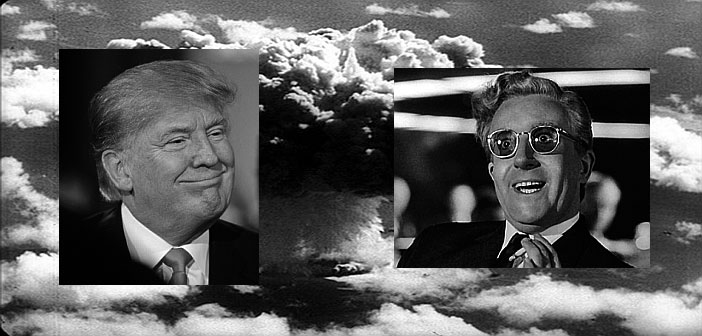“Kim Jong-un risks the end of his regime and the destruction of his people.” – US Secretary of Defence, General James ‘Mad Dog’ Mattis
Donald Trump’s threats of ‘fire and fury’ against North Korea are an expression of a new position in American government on the use of nuclear weapons. Any ambiguity over ‘no first use’ (NFU) has been swept away. The United States is prepared to use nuclear weapons first – official. And in defence spending it will prioritise improving nuclear weapons and the forward positioning their delivery systems.That Trump is threatening nuclear war against North Korea is not in doubt. A clarification of ‘fire and fury’ was given on August 9 by US Secretary of Defence, General James Mattis, when he said that North Korean leader Kim Jong-un risked “the end of his regime and the destruction of his people”. Literally this is a threat of genocide.
The new doctrine of nuclear aggression was prefigured in a 2016 article in the National Interest magazine entitled ‘America must be Prepared to Nuke First’, by former Marine colonel Guy B Roberts, Trump’s new under-secretary of defence for nuclear policy.
The article, which came out before the presidential election, said:
“The president (Obama) declared in his 2009 Prague speech his determination to seek the ‘peace and security of a world without nuclear weapons’. However, one of the proposals being seriously considered is to declare ‘no first use’ (NFU). This is unwise, inherently dangerous and could very well have the opposite effect by substantially weakening the ability of the United States and its allies to effectively deter aggression.”
Despite Obama toying with NFU, it has never been US policy. During the Cold War the Soviet Union repeatedly stated its adherence to NFU, but the United States refused to respond in kind. The justification for this was the calculation that if war broke out in Europe, the Soviet’s Union’s (alleged) superiority in tanks and other conventional weapons might lead to Western Europe being overrun. If this were about to happen, so the argument went, the US and its allies would have to respond with ‘tactical’ (aka ‘battlefield’) nuclear weapons. Of course the whole discussion was absurd because the Soviet Union, which had mainly a defensive posture throughout the Cold War and whose leaders were only too aware of the loss of 25 million Soviet citizens during the last European war, had no intention whatever of invading Western Europe.
During the Cold War, in popular imagination peace was preserved by the doctrine of Mutually Assured Destruction (‘MAD’). Neither side would use nuclear weapons because it would lead to an all-out exchange and both sides being destroyed. There was doubtless a strong element of truth in this assessment, but the United States never wholly subscribed to it, imagining that a tactical exchange could be limited to the ‘battlefield’ (ie Europe).
Roberts argues that if NFU were to be adopted it would give a blank cheque to enemies to do anything short of using nuclear weapons:
“NFU removes the uncertainty built into our deterrence posture by removing a major risk. Ruling out, in advance, the necessity for an aggressor to consider all of NATO’s political and military options would weaken deterrence by removing uncertainty. An adversary could then conclude that, as long as he (sic) doesn’t use nuclear weapons, the way is open for aggression using all means available to him, to include other weapons of mass destruction.”
Roberts is specific about the potential adversaries that the threat of nuclear attack might be aimed at – Iran, China, North Kore and Russia. Because the present international situation is unstable and unpredictable, no a priori restrictions of US action can be allowed:
“On its face, no-first-use proposals are dangerous and undermine deterrence stability. Those that are responsible for maintaining our deterrence posture understand that war is so indeterminate that no firm predictions can be made as to its likely course and therefore no established limitations can be guaranteed to hold. In a recent hearing before the House Armed Services subcommittee on strategic forces, Adm. Cecil D. Haney, head of Strategic Command, said the current security environment is dangerous and unpredictable and made more so by, among other things, ‘the increasingly provocative and destabilizing behavior by potential adversaries like Russia, China, North Korea, and Iran.’ Adopting a policy in which conventional and biological/chemical aggression no longer need fear nuclear retaliation opens the door for even more ‘provocative and destabilizing behavior’ by our potential foes.”
Notable in this article is its purely political-military calculus, with no reference to social and environmental costs whatsoever. The immediate deaths of hundreds of thousands of people (at least), the littering of the atmosphere with nuclear fall-out leading to many more deaths world-wide over time, the poisoning of ecosystems, the destruction of habitats and the wrecking of cities – these are all just ignored.
Roberts was also a contributing author to a key report produced by the right-wing National Institute for Public Policy, A New Nuclear Review for a New Age, itself produced in response to Trump initiating a government review of nuclear policy. (This review should be out in October, but now is mainly of academic interest, as its initiator has jumped the gun rather spectacularly).
The New Nuclear Review is clearly an attempt to do what the Project for the New American Century did in 1997 – set the parameters for the US military posture in the coming period. The 1997 report, in which future members of the 2000-2008 George Bush administration like Paul Wolfowitz, Donald Rumsfeld and Dick Cheney participated, called for regime change in Iraq and boosting defence spending to enable rapid American intervention in a variety of conflicts. All this was put into operation in Afghanistan and Iraq. But it did not focus mainly on nuclear weapons or nuclear strategy.
In concentrating on the centrality of nuclear weapons, the New Nuclear Review takes aim at projects for non-proliferation or talks about reducing nuclear weapons numbers. It builds on the decisions already taken by the Obama administration to produce smaller tactical nuclear weapons, which as Damon Poeter explains, were already under criticism for being arguably more tempting to use.
The Review rejects the obvious – the idea that states like Iran and North Korea might be seeking nuclear capability in order to deter the United States. It also rejects the even more blindingly obvious, that some of today’s nine nuclear states acquired nuclear weapons to counter the threat from the United States. For example:
“Rather than supporting the claim that US nuclear reductions contribute to nonproliferation, empirical evidence supports the notion that the character of the US nuclear arsenal does not contribute to nuclear proliferation. There reportedly are nine countries with nuclear weapons in the world today, but none appears to have acquired nuclear weapons because of the size of the US nuclear arsenal or because Washington did not do more to de-emphasize nuclear weapons. Careful examination of the histories of these countries’ nuclear programs has identified several important motivators, including international security threats, but none of these histories points to a lack of US nuclear disarmament as a cause of nuclear proliferation.” (Review p213).
The idea that the American nuclear weapons were not part of the decisions of China and the Soviet Union to become nuclear powers themselves is literally incredible. Even if you argue that China wanted also to deter the Soviet Union, then you have to ask why the Soviet Union developed its own nuclear arsenal.
Moreover:
“…despite decades of research and numerous identified causes other than the positive linkage of US nuclear forces to the assurance of allies, academic analyses have not found any serious evidence supporting the claim that the size or direction of the US nuclear arsenal is an important determinant of nuclear proliferation….In short, beyond the potential linkage to proliferation among US allies dependent on extended deterrence, the US nuclear posture is likely a peripheral, if not completely irrelevant, consideration in other states’ proliferation decisions.” (Review p212)
What this is really all about – the need to have more and better nukes for America – can be clearly seen below:
“There is no evidence, for example, to suggest that foreign leaders would be more likely to build nuclear weapons if the United States possessed the 2,200 accountable strategic nuclear weapons permitted under the 2002 Moscow Treaty, the 1,550 accountable nuclear warheads as agreed to in the 2010 New START Treaty, or the approximately 1,000 nuclear warheads President Obama proposed in the summer of 2013.” (Review p.212)
Further on the Review actually claims more and better nuclear weapons for the US strengthen moves towards non-proliferation (Review p. 227).
The Chair of the Review team is Keith Payne, President of the rightwing National Institute for Public Policy, the think-tank behind the Review. The Institute is described on the Right Web website as:
“…a Washington, D.C.-based think tank closely associated with defense contractors as well as a family of like-minded advocacy groups that promote militarist security policies. When it was founded in 1981, NIPP served as a home for classic Cold Warriors bent on developing ‘winnable’ nuclear war strategies.”
Payne was a graduate student at the Rand Corporation’s Hudson Institute, studying under Hermann Khan, who in the early 1960s published his notorious books On Thermonuclear War and Thinking the Unthinkable. In these books he argued that nuclear war was indeed thinkable, and indeed survivable, for the United States. Payne describes Khan as “a genius”. He was the main inspiration for the character of the insane Dr Strangelove in the Stanley Kubrick movie.
Herman Khan’s theories never became official policy. But in the appointment of Guy Roberts to be the Defence under-secretary for nuclear policy, Trump is making a direct link to the ‘children of Herman Khan’, people who think that nuclear war is thinkable and nuclear weapons are usable.
This is happening in a world of deepening nuclear instability. As Richard Tanter points out:
“All nine nuclear-weapon states are modernising their nuclear arsenals… It is entirely possible that Trump will ditch the Obama administration’s deal with Iran. A cascade of Saudi Arabian, Turkish and Egyptian nuclear wannabes would be almost inescapable. Trump’s encouragement of Japanese and South Korean nuclear breakout fits all too well with the ambitions of the Abe cabinet in Japan, and the majority of South Koreans who support a Korean nuclear force. We will also see renewed support for Australian nuclear weapons in the name of self-reliance….
“Shifts in technology and doctrine are encouraging belief among strategists that nuclear weapons are ‘usable’—that single detonations or small numbers can be used in war without leading to ‘uncontrollable escalation’.”
This year’s US defence budget has gone up from $598 billion last year to $660 billion. Nearly all of the increase is accounted for by upgrading America’s nuclear arsenal. The danger of nuclear war is frighteningly real.

